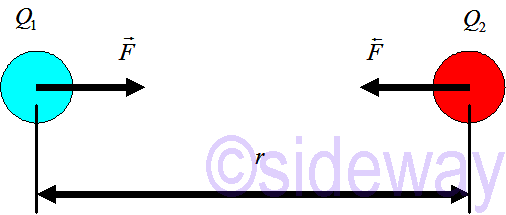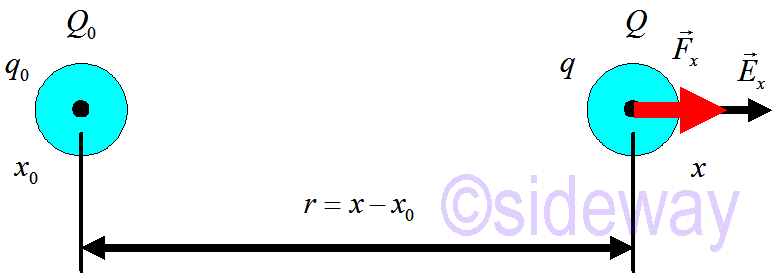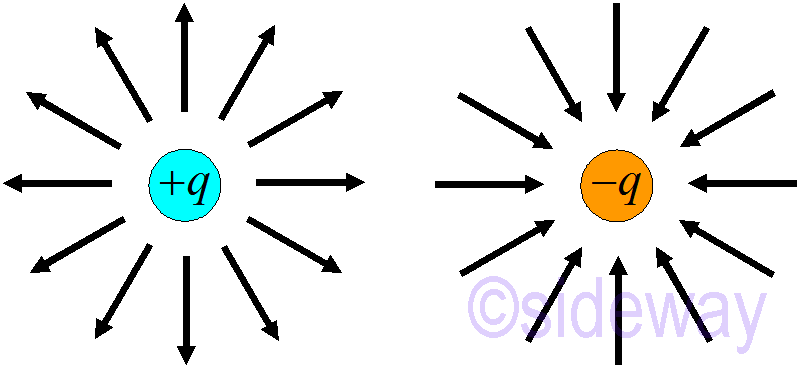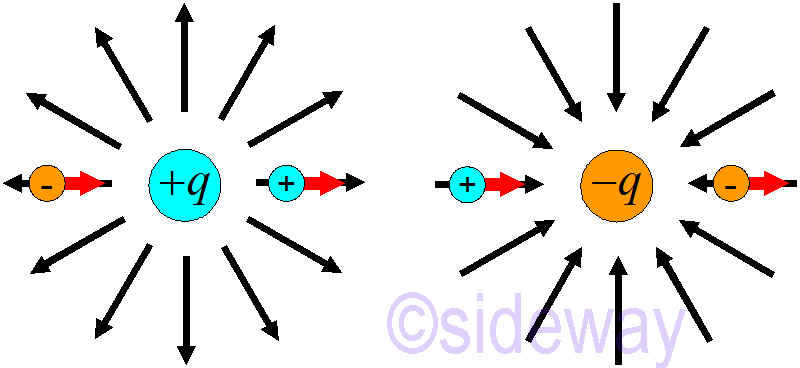Content
Coulomb's law
Electrostatic Force
Electric Field
Source and Reference
Coulomb's law
Coulomb's law or Coulomb's inverse-square law is a low of physics used to quantify the amount of force between two stationary elctrically charged particles.
Electrostatic Force

Electrostatic force or Coulomb force is defined as the electric force between two charged bodies at rest. The quantity of electrostatic force between stationary charges is always described by Coulomb's law.
𝐹
=14𝜋𝜀𝑒
𝑄1𝑄2𝑟2
𝑟
=𝑘𝑒𝑄1𝑄2𝑟2
𝑟
The direction of force is attractive if charges have opposite sign as above and is repulsive if charges have same sign as below. The electrostatic force always acts along a line connecting tht charges

The magnitude of electrostatic force is proportional to the magnitude of each charge and inversely proportional to the distance squared
𝐹
=𝐹=14𝜋𝜀𝑒
|𝑄1𝑄2|𝑟2
=𝑘𝑒|𝑄1𝑄2|𝑟2
The unit of electric charge, 𝑄 in SI unit is Coulomb, 𝐶. The unit of electrostatic force, 𝐹 is 𝑁. The unit of distance, 𝑟 is 𝑚. Therefore the unit of permittivity, 𝜀 is 𝐶2/𝑁𝑚2.
The vacuum permittivity, 𝜀0 is equal to 8.85×10-12𝐶2/𝑁𝑚2=8.85×10-12𝐹𝑚-1. The Coulomb's constant, 𝑘𝑒 for vacuum, 1/4𝜋𝜀0 is 9×109𝑁𝑚2/𝐶2
The electric charge of an electron, 𝑒 is 1.602×10-19𝐶. The electric charge quantity of an electron, 𝑄 is −𝑒, while the electric charge quantity of a proton, 𝑄 is +𝑒.
Electric Field
From Coulomb's law, a particle with electric charge, 𝑄0 at position, 𝑥0 exerts a force on a particle with electric charge, 𝑄1 at position, 𝑥1 can be expressed as𝐹
=14𝜋𝜀0
𝑄0𝑄1(𝑥1−𝑥0)2
𝑟
𝐹0,1𝑄1
=14𝜋𝜀0
𝑄0(𝑥1−𝑥0)2
𝑟
0,1𝐸
𝑥=𝐹𝑥𝑄
=14𝜋𝜀0
𝑄0(𝑥−𝑥0)2
𝑟
𝑥 In other words, the electrostatic force that acts on any charge can be expressed as
In other words, the electrostatic force that acts on any charge can be expressed as
𝐹=𝑞𝐸
=14𝜋𝜀0
𝑞0𝑟2
𝑟
 The direction of electrostatic force acting on an charaged observed particle due to the electic field generated by a charged source particle depends on the signes of the two charged particles. However, a positively charged observed particle alway experences an electrostatic force which is along with the same direction of electric field, while a negatively charged observed particle particle alway experences an electrostatic force which is against the direction of electric field, i.e. in the opposite direction of electric field.
The direction of electrostatic force acting on an charaged observed particle due to the electic field generated by a charged source particle depends on the signes of the two charged particles. However, a positively charged observed particle alway experences an electrostatic force which is along with the same direction of electric field, while a negatively charged observed particle particle alway experences an electrostatic force which is against the direction of electric field, i.e. in the opposite direction of electric field.

Source and Reference
https://www.youtube.com/watch?v=v57B_1ZBAho&list=PLZ6kagz8q0bvxaUKCe2RRvU_h7wtNNxxi&index=1
©sideway
ID: 191003002 Last Updated: 10/30/2019 Revision: 0
Latest Updated Links
- Panasonic SR-CK05 RiceCooker CW-HZ70AA(last updated On 11/17/2025)
- Panasonic Hood Structure Ventilating Fan Blade Diameter: 8in FV-20WH307 CW-HZ70AA(last updated On 11/16/2025)
- Panasonic Window Mount Thermo Ventilator FV-30BW2H CW-HZ70AA(last updated On 11/15/2025)
- Panasonic Inverter PRO Inverter Window Heatpump Air-Conditioner (3/4 HP) CW-HZ70AA(last updated On 11/14/2025)
- Panasonic Inverter Window-Split Type Cooling Only Air-Conditioner (1 HP) CS-U9YWA(last updated On 11/13/2025)
- Panasonic Inverter Steam and Grill_Microwave Oven 27L NN_DS59NB(last updated On 11/12/2025)
- Panasonic KY-C223B Induction Cooker(last updated On 11/11/2025)
- Focus M41 Single lever kitchen mixer 160(last updated On 11/10/2025)
- Focus Single lever basin mixer 230(last updated On 11/9/2025)
- Precision Start Thermostat shower mixer(last updated On 11/8/2025)
- Tempesta 100 Shower Rail Set 3 sprays(last updated On 11/7/2025)

 Nu Html Checker
Nu Html Checker  53
53  na
na  na
na
Home 5
Business
Management
HBR 3
Information
Recreation
Hobbies 8
Culture
Chinese 1097
English 339
Travel 18
Reference 79
Hardware 40
Computer
Hardware 259
Software
Application 213
Digitization 37
Latex 52
Manim 205
KB 1
Numeric 19
Programming
Web 289
Unicode 504
HTML 66
CSS 65
SVG 46
ASP.NET 270
OS 431
DeskTop 7
Python 72
Knowledge
Mathematics
Formulas 8
Set 1
Logic 1
Algebra 84
Number Theory 206
Trigonometry 31
Geometry 34
Calculus 67
Engineering
Tables 8
Mechanical
Rigid Bodies
Statics 92
Dynamics 37
Fluid 5
Control
Acoustics 19
Natural Sciences
Matter 1
Electric 27
Biology 1
